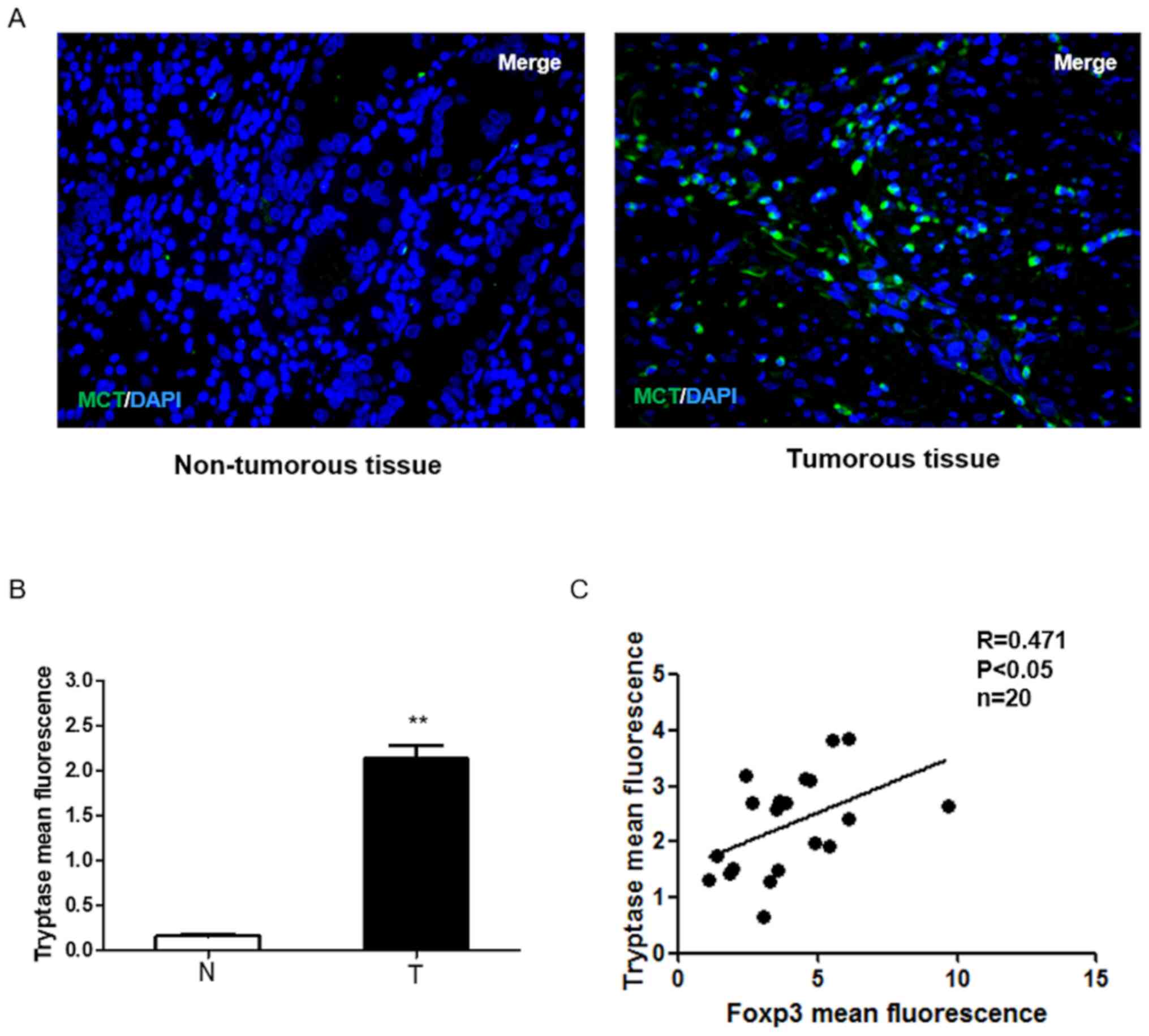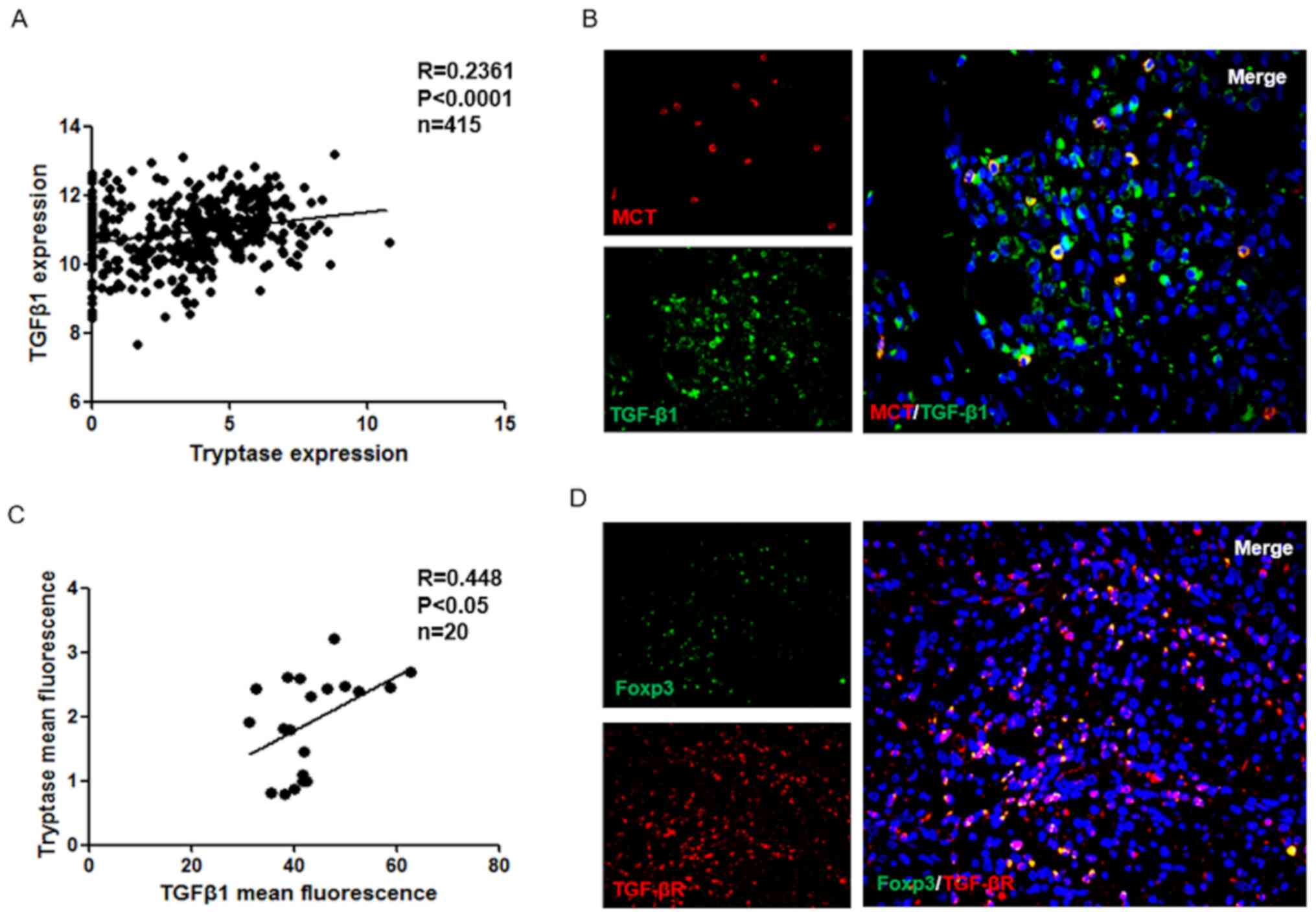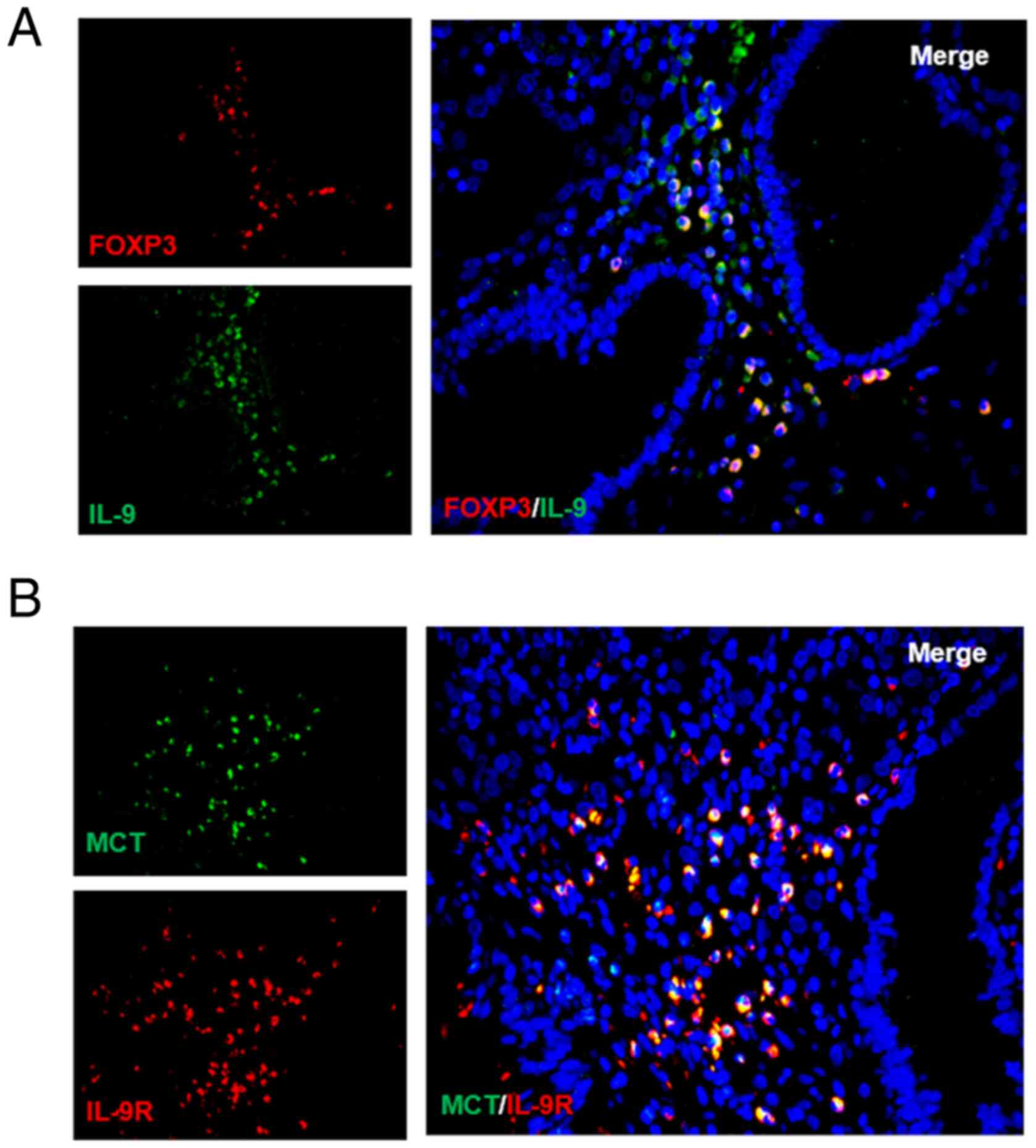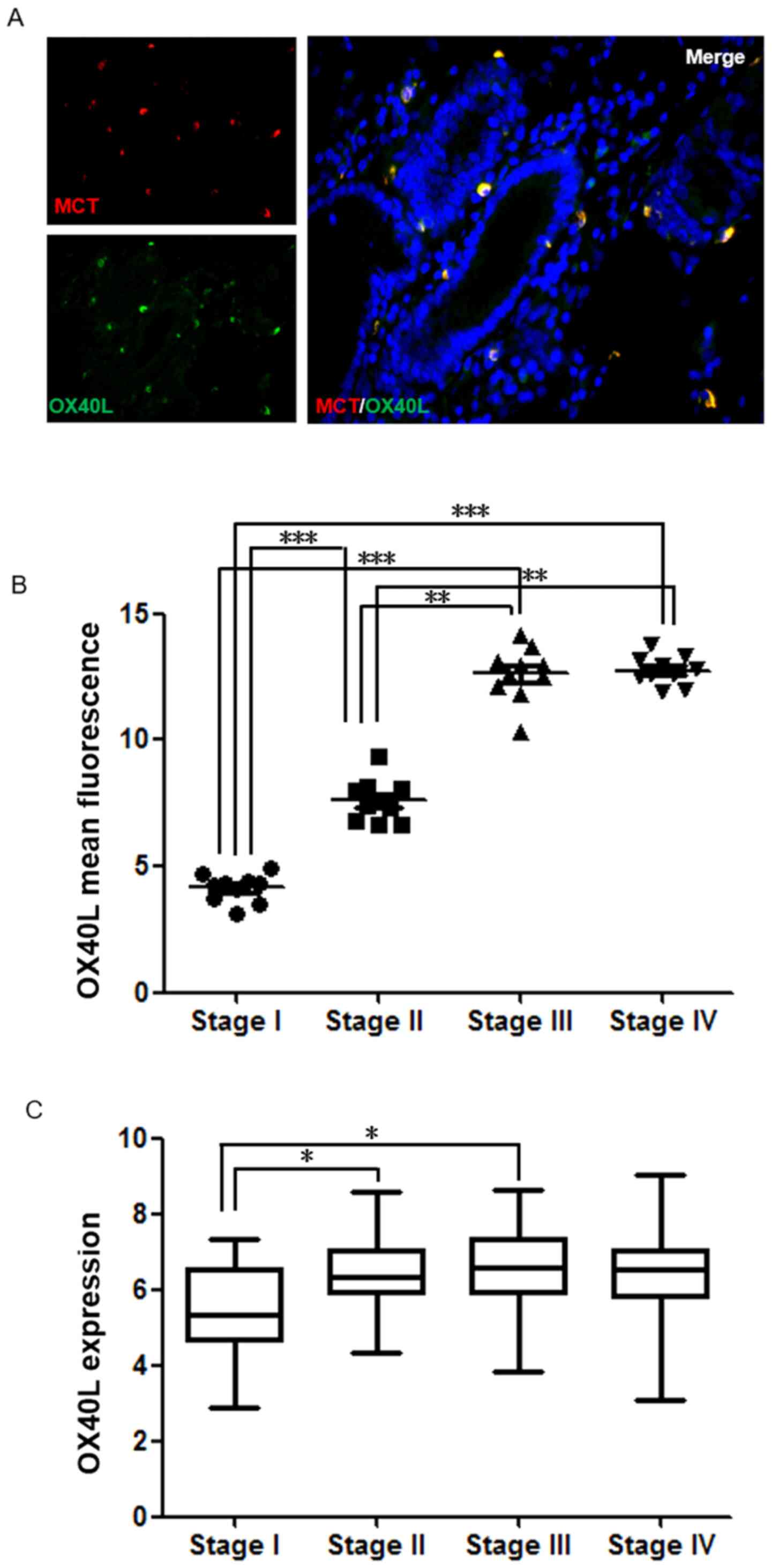|
1
|
Bray F, Ferlay J, Soerjomataram I, Siegel
RL, Torre LA and Jemal A: Global cancer statistics 2018: GLOBOCAN
estimates of incidence and mortality worldwide for 36 cancers in
185 countries. CA Cancer J Clin. 68:394–424. 2018. View Article : Google Scholar : PubMed/NCBI
|
|
2
|
Wang LH, Su L and Wang JT: Correlation
between elevated FOXP3 expression and increased lymph node
metastasis of gastric cancer. Chin Med J (Engl). 123:3545–3549.
2010.PubMed/NCBI
|
|
3
|
Yoshii M, Tanaka H, Ohira M, Muguruma K,
Iwauchi T, Lee T, Sakurai K, Kubo N, Yashiro M, Sawada T and
Hirakawa K: Expression of forkhead box P3 in tumour cells causes
immunoregulatory function of signet ring cell carcinoma of the
stomach. Br J Cancer. 106:1668–1674. 2012. View Article : Google Scholar : PubMed/NCBI
|
|
4
|
Tan Z: Recent advances in the surgical
treatment of advanced gastric cancer: A review. Med Sci Monit.
25:3537–3541. 2019. View Article : Google Scholar : PubMed/NCBI
|
|
5
|
Magalhães H, Fontes-Sousa M and Machado M:
Immunotherapy in advanced gastric cancer: An overview of the
emerging strategies. Can J Gastroenterol Hepatol.
2018:27324082018.PubMed/NCBI
|
|
6
|
Khazaie K, Blatner NR, Khan MW, Gounari F,
Gounaris E, Dennis K, Bonertz A, Tsai FN, Strouch MJ, Cheon E, et
al: The significant role of mast cells in cancer. Cancer Metastasis
Rev. 30:45–60. 2011. View Article : Google Scholar : PubMed/NCBI
|
|
7
|
Ribatti D and Crivellato E: Mast cells,
angiogenesis, and tumour growth. Biochim Biophys Acta. 1822:2–8.
2012. View Article : Google Scholar : PubMed/NCBI
|
|
8
|
Huang B, Lei Z, Zhang GM, Li D, Song C, Li
B, Liu Y, Yuan Y, Unkeless J, Xiong H and Feng ZH: SCF-mediated
mast cell infiltration and activation exacerbate the inflammation
and immunosuppression in tumor microenvironment. Blood.
112:1269–1279. 2008. View Article : Google Scholar : PubMed/NCBI
|
|
9
|
Rabinovich GA, Gabrilovich D and Sotomayor
EM: Immunosuppressive strategies that are mediated by tumor cells.
Annu Rev Immunol. 25:267–296. 2007. View Article : Google Scholar : PubMed/NCBI
|
|
10
|
Piconese S and Colombo MP: Regulatory T
cells in cancer. Blood. 108:804–811. 2006. View Article : Google Scholar : PubMed/NCBI
|
|
11
|
Fontenot JD, Gavin MA and Rudensky AY:
Foxp3 programs the development and function of CD4+CD25+ regulatory
T cells. Nat Immunol. 4:330–336. 2003. View
Article : Google Scholar : PubMed/NCBI
|
|
12
|
Kryczek I, Liu R, Wang G, Wu K, Shu X,
Szeliga W, Vatan L, Finlayson E, Huang E, Simeone D, et al: FOXP3
defines regulatory T cells in human tumor and autoimmune disease.
Cancer Res. 69:3995–4000. 2009. View Article : Google Scholar : PubMed/NCBI
|
|
13
|
Ribatti D and Crivellato E: Chapter 4 the
controversial role of mast cells in tumor growth. Int Rev Cell Mol
Biol. 275:89–131. 2009. View Article : Google Scholar : PubMed/NCBI
|
|
14
|
Ribatti D, Guidolin D, Marzullo A, Nico B,
Annese T, Benagiano V and Crivellato E: Mast cells and angiogenesis
in gastric carcinoma. Int J Exp Pathol. 91:350–356. 2010.
View Article : Google Scholar : PubMed/NCBI
|
|
15
|
Zhao Y, WU K, Cai K, Zhai R, Tao K, Wang G
and Wang J: Increased numbers of gastric-infiltrating mast cells
and regulatory T cells are associated with tumor stage in gastric
adenocarcinoma patients. Oncol Lett. 4:755–758. 2012. View Article : Google Scholar : PubMed/NCBI
|
|
16
|
De Smedt T, Smith J, Baum P, Fanslow W,
Butz E and Maliszewski C: Ox40 costimulation enhances the
development of T cell responses induced by dendritic cells in vivo.
J Immunol. 168:661–670. 2002. View Article : Google Scholar : PubMed/NCBI
|
|
17
|
Huang L, Wang M, Yan Y, Gu W, Zhang X, Tan
J, Sun H, Ji W and Chen Z: OX40L induces helper T cell
differentiation during cell immunity of asthma through PI3K/AKT and
P38 MAPK signaling pathway. J Transl Med. 16:742018. View Article : Google Scholar : PubMed/NCBI
|
|
18
|
Edge SB and Compton CC: The American joint
committee on cancer: The 7th edition of the AJCC cancer staging
manual and the future of TNM. Ann Surg Oncol. 17:1471–1474. 2010.
View Article : Google Scholar : PubMed/NCBI
|
|
19
|
Yuan XL, Chen L, Zhang TT, Ma YH, Zhou YL,
Zhao Y, Wang WW, Dong P, Yu L, Zhang YY and Shen LS: Gastric cancer
cells induce human CD4+Foxp3+ regulatory T cells through the
production of TGF-β1. World J Gastroenterol. 17:2019–2027. 2011.
View Article : Google Scholar : PubMed/NCBI
|
|
20
|
Wang J, Zhang Y, Zeng Y, Ge S, Sun X, Jia
M, Wu Y and Wang N: Isoimperatorin reduces the effective dose of
dexamethasone in a murine model of asthma by inhibiting mast cell
activation. Phytother Res. 2020.(Epub ahead of print). View Article : Google Scholar
|
|
21
|
Feng LL, Gao JM, Li PP and Wang X: IL-9
contributes to immunosuppression mediated by regulatory T cells and
mast cells in B-cell non-hodgkin's lymphoma. J Clin Immunol.
31:1084–1094. 2011. View Article : Google Scholar : PubMed/NCBI
|
|
22
|
Yu F, Tian T, Deng B, Wang T, Qi Q, Zhu M,
Yan C, Ding H, Wang J, Dai J, et al: Multi-marker analysis of
genomic annotation on gastric cancer GWAS data from Chinese
populations. Gastric Cancer. 22:60–68. 2019. View Article : Google Scholar : PubMed/NCBI
|
|
23
|
Muro K, Chung HC, Shankaran V, Geva R,
Catenacci D, Gupta S, Eder JP, Golan T, Le DT, Burtness B, et al:
Pembrolizumab for patients with PD-L1-positive advanced gastric
cancer (KEYNOTE-012): A multicentre, open-label, phase 1b trial.
Lancet Oncol. 17:717–726. 2016. View Article : Google Scholar : PubMed/NCBI
|
|
24
|
Lis R, Touboul C, Mirshahi P, Ali F,
Mathew S, Nolan DJ, Maleki M, Abdalla SA, Raynaud CM, Querleu D, et
al: Tumor associated mesenchymal stem cells protects ovarian cancer
cells from hyperthermia through CXCL12. Int J Cancer. 128:715–725.
2011. View Article : Google Scholar : PubMed/NCBI
|
|
25
|
Ogino S, Shima K and Baba Y: Colorectal
cancer expression of peroxisome proliferator-activated
receptor-gamma (PPARG, PPARgamma)is associated with good prognosis.
Gastroenterology. 136:1242–1250. 2009. View Article : Google Scholar : PubMed/NCBI
|
|
26
|
Sinnamon MJ, Carter KJ, Sims LP, Lafleur
B, Fingleton B and Matrisian LM: A protective role of mast cells in
intestinal tumorigenesis. Carcinogenesis. 29:880–886. 2008.
View Article : Google Scholar : PubMed/NCBI
|
|
27
|
Zhao YB, Wang JL and Wang GB: The function
of mast cells in gastric cancer. Gastroenterology. 19:2246–2250.
2011.
|
|
28
|
Sasada T, Kimura M, Yoshida Y, Kanai M and
Takabayashi A: CD4+CD25+ regulatory T cells
in patients with gastrointestinal malignancies: Possible
involvement of regulatory T cells in disease progression. Cancer.
98:1089–1099. 2003. View Article : Google Scholar : PubMed/NCBI
|
|
29
|
Shen Z, Zhou S, Wang Y, Li RL, Zhong C,
Liang C and Sun Y: Higher intratumoral infiltrated
Foxp3+ Treg numbers and
Foxp3+/CD8+ ratio are associated with adverse
prognosis in resectable gastric cancer. J Cancer Res Clin Oncol.
136:1585–1595. 2010. View Article : Google Scholar : PubMed/NCBI
|
|
30
|
Mizukami Y, Kono K, Kawaguchi Y, Akaike H,
Kamimura K, Sugai H and Fujii H: Localisation pattern of
Foxp3+ regulatory T cells is associated with clinical
behaviour in gastric cancer. Br J Cancer. 98:148–153. 2008.
View Article : Google Scholar : PubMed/NCBI
|
|
31
|
Bataller A, Montalban-Bravo G, Soltysiak
KA and Garcia-Manero G: The role of TGFβ in hematopoiesis and
myeloid disorders. Leukemia. 33:1076–1089. 2019. View Article : Google Scholar : PubMed/NCBI
|
|
32
|
Zhu H, Luo H, Shen Z, Hu X, Sun L and Zhu
X: Transforming growth factor-β1 in carcinogenesis, progression,
and therapy in cervical cancer. Tumour Biol. 37:7075–7083. 2016.
View Article : Google Scholar : PubMed/NCBI
|
|
33
|
Syed V: TGF-β signaling in cancer. J Cell
Biochem. 117:1279–1287. 2016. View Article : Google Scholar : PubMed/NCBI
|
|
34
|
Schwartz M, Zhang Y and Rosenblatt JD: B
cell regulation of the anti-tumor response and role in
carcinogenesis. J Immunother Cancer. 4:402016. View Article : Google Scholar : PubMed/NCBI
|
|
35
|
Elieh Ali Komi D and Grauwet K: Role of
mast cells in regulation of T cell responses in experimental and
clinical settings. Clin Rev Allergy Immunol. 54:432–445. 2018.
View Article : Google Scholar : PubMed/NCBI
|
|
36
|
Matsuzawa S, Sakashita K, Kinoshita T, Ito
S, Yamashita T and Koike K: IL-9 enhances the growth of human mast
cell progenitors under stimulation with stem cell factor. J
Immunol. 170:3461–3467. 2003. View Article : Google Scholar : PubMed/NCBI
|
|
37
|
Townsend JM, Fallon GP, Matthews JD, Smith
P, Jolin EH and McKenzie NA: IL-9-deficient mice establish
fundamental roles for IL-9 in pulmonary mastocytosis and goblet
cell hyperplasia but not T cell development. Immunity. 13:573–583.
2000. View Article : Google Scholar : PubMed/NCBI
|
|
38
|
Schmitt E, Van Brandwijk R, Van Snick J,
Siebold B and Rüde E: Tcgfiii/p40 is produced by naive murine
cd4+ t cells but is not a general t cell growth factor.
Eur J Immunol. 19:2167–2170. 1989. View Article : Google Scholar : PubMed/NCBI
|
|
39
|
Lu LF, Lind EF, Gondek DC, Bennett KA,
Gleeson MW, Pino-Lagos K, Scott ZA, Coyle AJ, Reed JL, Van Snick J,
et al: Mast cells are essential intermediaries in regulatory T-cell
tolerance. Nature. 442:997–1002. 2006. View Article : Google Scholar : PubMed/NCBI
|
|
40
|
Beriou G, Bradshaw EM, Lozano E,
Costantino CM, Hastings WD, Orban T, Elyaman W, Khoury SJ, Kuchroo
VK, Baecher-Allan C and Hafler DA: TGF-beta induces IL-9 production
from human Th17 cells. J Immunol. 185:46–54. 2010. View Article : Google Scholar : PubMed/NCBI
|
|
41
|
Putheti P, Awasthi A, Popoola J, Gao W and
Strom TB: Human CD4+ memory T cells can become
CD4+IL-9+ T cells. PLoS One. 5:e87062010.
View Article : Google Scholar : PubMed/NCBI
|
|
42
|
Sehra S, Yao W, Nguyen ET, Glosson-Byers
NL, Akhtar N, Zhou B and Kaplan MH: TH9 cells are required for
tissue mast cell accumulation during allergic inflammation. J
Allergy Clin Immunol. 136:433–40.e1. 2015. View Article : Google Scholar : PubMed/NCBI
|
|
43
|
Hauber HP, Bergeron C and Hamid Q: IL-9 in
allergic inflammation. Int Arch Allergy Immunol. 134:79–87. 2004.
View Article : Google Scholar : PubMed/NCBI
|
|
44
|
Renga G, Moretti S, Oikonomou V, Borghi M,
Zelante T, Paolicelli G, Costantini C, De Zuani M, Villella VR,
Raia V, et al: IL-9 and mast cells are key players of candida
albicans commensalism and pathogenesis in the gut. Cell Rep.
23:1767–1778. 2018. View Article : Google Scholar : PubMed/NCBI
|
|
45
|
Eller K, Wolf D, Huber JM, Metz M, Mayer
G, McKenzie ANJ, Maurer M, Rosenkranz AR and Wolf AM: IL-9
production by regulatory T cells recruits mast cells that are
essential for regulatory T cell-induced immune-suppression. J
Immunol. 186:83–91. 2011. View Article : Google Scholar : PubMed/NCBI
|
|
46
|
Webb GJ, Hirschfield GM and Lane PJL:
OX40, OX40L and autoimmunity: A comprehensive review. Clin Rev
Allergy Immunol. 50:312–332. 2016. View Article : Google Scholar : PubMed/NCBI
|
|
47
|
Kashiwakura J, Yokoi H, Saito H and
Okayama Y: T cell proliferation by direct cross-talk between OX40
ligand on human mast cells and OX40 on human T cells: Comparison of
gene expression profiles between human tonsillar and lung-cultured
mast cells. J Immunol. 173:5247–5257. 2004. View Article : Google Scholar : PubMed/NCBI
|
|
48
|
Nakae S, Suto H, Kakurai M, Sedgwick JD,
Tsai M and Galli SJ: Mast cells enhance T cell activation:
Importance of mast cell-derived TNF. Proc Natl Acad Sci USA.
102:6467–6472. 2005. View Article : Google Scholar : PubMed/NCBI
|
|
49
|
Imura A, Hori T, Imada K, Ishikawa T,
Tanaka Y, Maeda M, Imamura S and Uchiyama T: The human OX40/gp34
system directly mediates adhesion of activated T cells to vascular
endothelial cells. J Exp Med. 183:2185–2195. 1996. View Article : Google Scholar : PubMed/NCBI
|
|
50
|
Ebert MP, Yu J, Miehlke S, Fei G,
Lendeckel U, Ridwelski K, Stolte M, Bayerdörffer E and
Malfertheiner P: Expression of transforming growth factor beta-1 in
gastric cancer and in the gastric mucosa of first-degree relatives
of patients with gastric cancer. Br J Cancer. 82:1795–1800. 2000.
View Article : Google Scholar : PubMed/NCBI
|


















